
The Battle of San Jacinto, fought on April 21, 1836, in present-day La Porte and Deer Park, Texas, was the final and decisive battle of the Texas Revolution. Led by General Samuel Houston, the Texan Army engaged and defeated General Antonio López de Santa Anna's Mexican army in a fight that lasted just 18 minutes. A detailed, first-hand account of the battle was written by General Houston from the headquarters of the Texan Army in San Jacinto on April 25, 1836. Numerous secondary analyses and interpretations have followed.
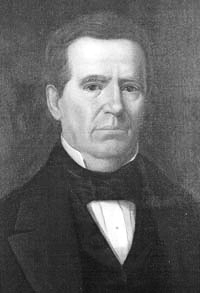
Anson Jones was a doctor, businessman, member of Congress, and the fourth and last president of the Republic of Texas.
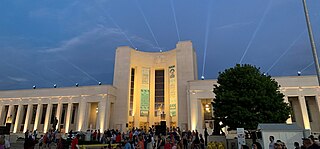
The Hall of State is a building in Dallas's Fair Park that commemorates the history of the U.S. state of Texas and is considered one of the best examples of Art Deco architecture in the state. It was designed and built for the Texas Centennial Exposition.
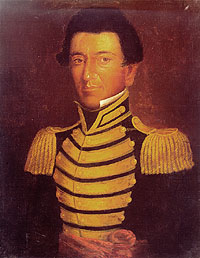
Juan Nepomuceno Seguín was a Spanish-Tejano political and military figure of the Texas Revolution who helped to establish the independence of Texas. Numerous places and institutions are named in his honor, including the county seat of Seguin in Guadalupe County, the Juan N. Seguin Memorial Interchange in Houston, Juan Seguin Monument in Seguin, World War II Liberty Ship SS Juan N. Seguin, Seguin High School in Arlington.

The San Jacinto Monument is a 567.31-foot-high (172.92-meter) column located on the Houston Ship Channel in unincorporated Harris County, Texas, about 16 miles due east of downtown Houston. The Art Deco monument is topped with a 220-ton star that commemorates the site of the Battle of San Jacinto, the decisive battle of the Texas Revolution. The monument, constructed between 1936 and 1939 and dedicated on April 21, 1939, is the world's tallest masonry column and is part of the San Jacinto Battleground State Historic Site. By comparison, the Washington Monument is 554.612 feet (169.046 m) tall, which is the tallest stone monument in the world. The column is an octagonal shaft topped with a 34-foot (10 m) Lone Star – the symbol of Texas. Visitors can take an elevator to the monument's observation deck for a view of Houston and the San Jacinto battlefield.

The Texas State Cemetery (TSC) is a cemetery located on about 22 acres (8.9 ha) just east of downtown Austin, the capital of the U.S. state of Texas. Originally the burial place of Edward Burleson, Texas Revolutionary general and vice-president of the Republic of Texas, it was expanded into a Confederate cemetery during the Civil War. Later it was expanded again to include the graves and cenotaphs of prominent Texans and their spouses.

San Jacinto High School was a secondary school located at 1300 Holman Street in Houston, Texas; now part of the Houston Community College Central College, Central Campus. San Jacinto High School was located in the area now known as Midtown. It was a part of the Houston Independent School District (HISD). It was listed on the National Register of Historic Places (NRHP) on December 4, 2012.

Laurel Hill Cemetery, also called Laurel Hill East to distinguish it from the affiliated West Laurel Hill Cemetery in Bala Cynwyd, is a historic rural cemetery in the East Falls neighborhood of Philadelphia. Founded in 1836, it was the second major rural cemetery in the United States after Mount Auburn Cemetery in Boston, Massachusetts.

Alfonso Parcutt Steele was one of the last remaining survivors of the Battle of San Jacinto during the Texas Revolution, and second-to-last survivor of Sam Houston's Army.
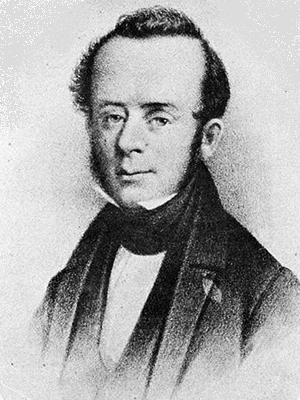
John Kirby Allen, was a co-founder of the city of Houston and a former member of the Republic of Texas House of Representatives. He was born in Canaseraga Village, New York. He never married. He died of congestive fever on August 15, 1838, and was buried at Founders Memorial Cemetery in Houston, Texas.
David Thomas was a signatory of the Texas Declaration of Independence and the first Attorney General and acting Secretary of War of the Republic of Texas.
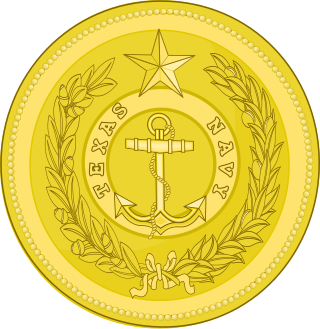
The Texas Navy, officially the Navy of the Republic of Texas, also known as the Second Texas Navy, was the naval warfare branch of the Texas Military Forces during the Republic of Texas. It descended from the Texian Navy, which was established in November 1835 to fight for independence from Centralist Republic of Mexico in the Texas Revolution. The Texas Navy, Texas Army, and Texas Militia were officially established on September 5, 1836 in Article II of the Constitution of the Republic of Texas. The Texas Navy and Texas Army were merged with the United States Armed Forces on February 19, 1846 after the Republic of Texas became the 28th state of the United States.

The San Jacinto Battleground State Historic Site includes the location of the Battle of San Jacinto and the museum ship USS Texas. It is located off the Houston Ship Channel in unincorporated Harris County, Texas near the city of Houston. The site was designated a National Historic Landmark in 1960.

The Texan schooner San Jacinto was a two-masted schooner of the Second Texas Navy from 1839 to 1840. She was the sister ship of the San Antonio and the San Bernard. In 1840, San Jacinto was part of the Texas Navy flotilla led by Commodore Edwin Ward Moore which was dispatched to assist Yucatecan rebels that had taken up arms against Mexico. In a storm, San Jacinto ran aground at Cayos Arcas and was wrecked. The crew were rescued by the flagship Austin.

The Star of the Republic Museum, in Washington, Texas, United States, is the only museum in the state of Texas created specifically to collect and interpret the culture and history of the Republic of Texas from 1836 to 1846. Within the museum's two floors of exhibits, visitors can learn about the history of the time period through media experiences, as well as informative exhibits. The site of the Star of the Republic Museum was selected at Washington on the Brazos where elected delegates gathered on March 2, 1836, to declare Texas’ independence from Mexico.
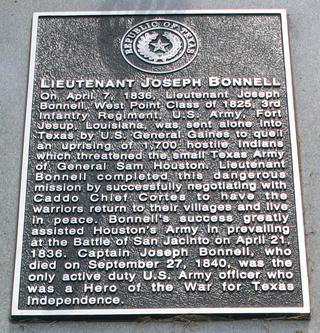
Joseph Bonnell was a formally recognized hero of the Texas Revolution. He was a West Point graduate and a member of The Long Gray Line.

Congregation Beth Israel is a Reform Jewish congregation and synagogue located at 5600 North Braeswood Boulevard, in Houston, Texas, in the United States. The congregation, founded in 1854, is the oldest Jewish congregation in Texas; and it operates the Shlenker School.

José Antonio Menchaca was an American soldier and politician who fought in the Texas Revolution and was recognized by a Joint Resolution of the Republic of Texas on December 22, 1838. Following the war, Menchaca served on the city council of San Antonio, Texas. He later commanded militia troops and helped defend the town from a Mexican invasion by General Adrian Woll in 1842.
James Thompson Collinsworth was an American-born Texian lawyer and political figure in early history of the Republic of Texas.



















